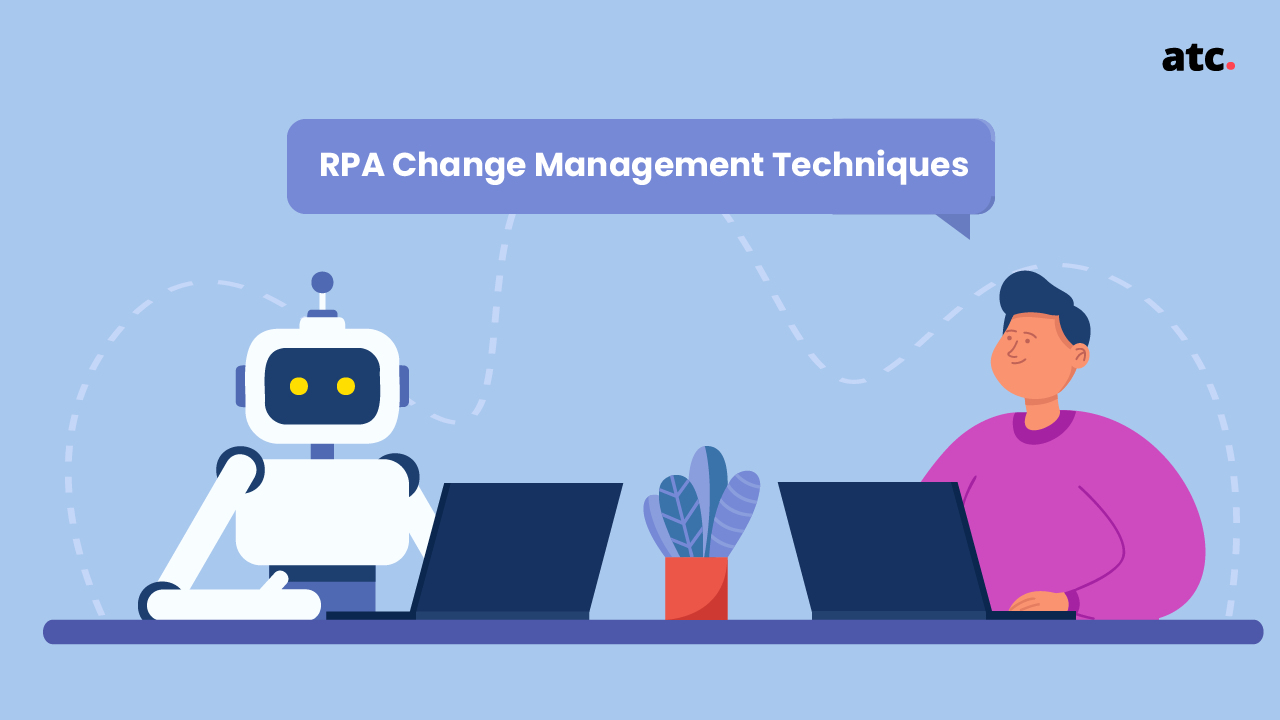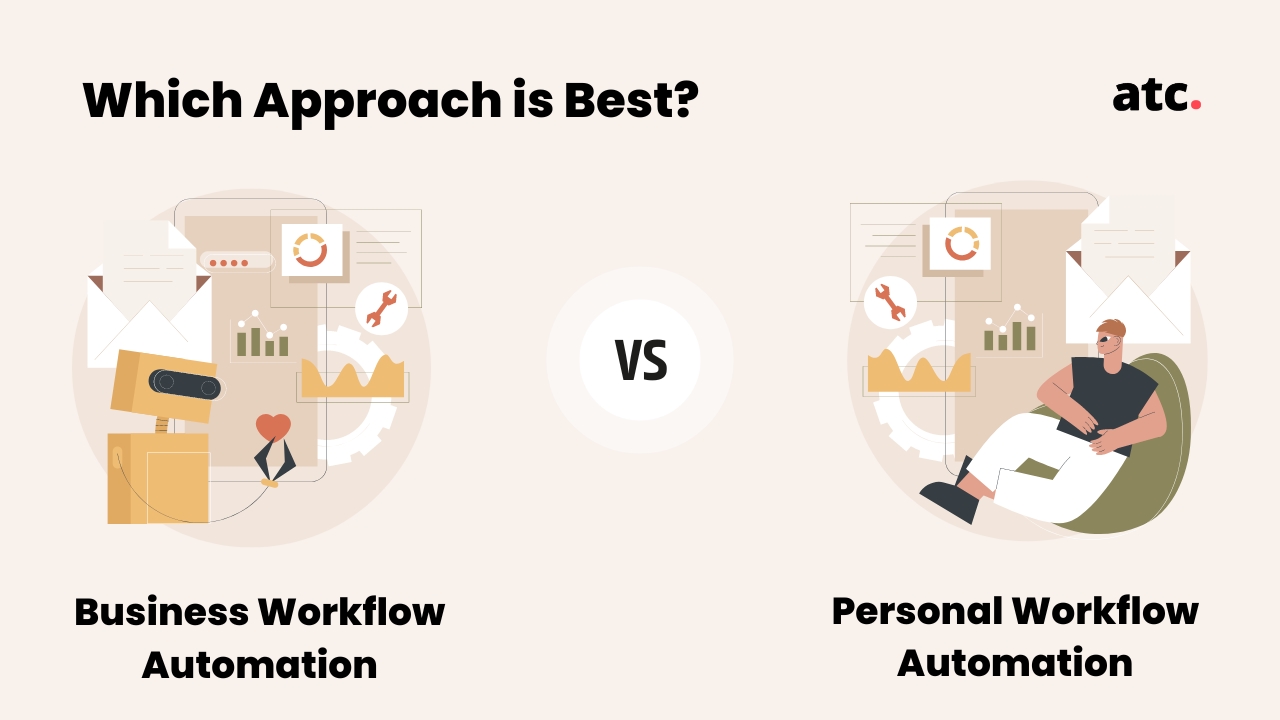Subscribe to the blog
As explained in a Global IA Report by the SSON (Shared Services and Outsourcing Network) 44% of Robotic Process Automation projects fail due to a lack of effective change management while implementing changes or upgrades in automation projects. Despite this, companies tend to undervalue the process of change management often.
RPA change management involves managing the future of the company with respect to these three elements: process, organization, and people. We must fundamentally be prepared to redefine things in order to ensure synergy between these three. There are strategies and approaches that can be helpful in addressing the problems that arise when managing organizational transformation with RPA. In order for a smooth transition and to facilitate the change that comes with it, it’s important for us to understand Change Management.
Let’s understand in detail what exactly is ‘Change Management', what the challenges faced by companies are, and what can be done to overcome those challenges.
What is Change Management?
A methodical strategy to deal with the transition or transformation of an organization's objectives, procedures, or technologies can be summarised as change management. Implementing ways to bring about change, manage change, and assist individuals in adapting to change is the general goal of change management.
Why is Change Management important in RPA?
Change Management is the process of managing changes in an organization or system. Change management is important to RPA because it provides the necessary framework for ensuring that your system can be changed or updated without causing damage to the business or its customers.
Companies should adhere to change management best practices. Customizing a strategy to prevent issues specific to automation will ensure that the users of the RPA solution have high-level support. That way it will be easier to implement successfully and more people will be encouraged to use them. This entails collaborating closely with important figures at all levels of the organization, tackling significant problems, and concentrating on the advantages that the new solutions will offer.
RPAChange Management Challenges and How to Counter Them:
Limited knowledge and resources
The first step in change management is to inform your organization of how the change will impact operations. Insufficient information may lead to difficulties involving the use of functions, and understanding the advantages it will bring, particularly with regard to changes to the working environment.
Lack of technical support, assistance, and maintenance
Businesses must develop a plan for maintenance and evaluation because the RPA solutions implemented need to be examined on a regular basis. It is necessary to establish an internal team to assess whether the newly installed automation is working well. There can be issues with incompatibilities or errors that need higher technical expertise. Or simply concerns about how much RPA has helped or harmed the original process. The lack of technical support or assistance hampers the effectiveness of the newly made changes, which might affect the end result negatively.
That is why in order to handle the difficulties, a dedicated team would be able to help keep track of issues, convey them to the stakeholders, and then come up with the best possible solutions.
Lack of effective communication
Businesses stand to gain a great deal from automating certain, frequent, and repetitive tasks. However, it must be noted that not all organizational processes can be fully automated, especially in the initial cycle. The development of any automation solution should be carried out carefully and attentively so that the development team is able to assess the drawbacks that might arise sooner or later.
This is where communication plays a vital role. Effective communication can influence the narrative of how the stakeholders perceive change. Organizational transformation can be made efficient if you have a carefully thought-out communication strategy. Everyone involved in the process should be aware of the reasons why change is required and what is their part in it. With effective communication, you can help everyone understand the process and help them adapt to the change. It is a crucial part of change management to communicate and manage the expectations of the employees as well as the stakeholders and align them with what can be done.
Lack of Buy-in from the stakeholders/employees
Getting everyone on board with a new strategic technology project can be challenging. Get as many people as possible to support the initiative and the rest of the company is more inclined to pay attention. Getting everyone to agree on a common goal can be a very challenging task. But if you try to get all stakeholders involved early on, it might give them time to adapt and accept it. Make sure that no individual or team is left out, from the top brass down to the workforce. Create a well-designed, comprehensive training program to help everyone learn. With this strategy, you are far more likely to succeed in making the adaptation process seamless, hence making the change management process efficient.
Support from management will help ensure that every employee is aware of the wider vision and given the tools they need to deal with the change. That entails assisting people in understanding how it will be advantageous to the company as well as to them as an individual making life easier.
Resistance to change
Resistance to change is one of the major obstacles to the entire change management initiative. Employees may experience stress when there is any change that requires them to make a transition to new technology and its related processes. Unfamiliarity can cause suspicion, demotivation, and even negative opinions about the new process.
To avoid this, it is wise to communicate and educate everyone on the advantages the new technology will bring to the company. The opposition to change can be lessened by preparing in advance for roles and anticipated outcomes and making them known throughout the organization.
Support from management will help ensure that every employee is aware of the wider vision and given the tools they need to deal with the change. Understanding how it will be advantageous to the company as well as to them as an individual will lower the resistance from employees considerably.
Whenever a change is implemented or required in an existing RPA project, there is an impact on both sides of the project: the vendor and the client.
That is why efficient change management practices are crucial on both ends, which can be broken down into two parts - Information Technology (IT) Change Management and Organizational Change Management.
Information Technology (IT) Change Management best practices for RPA
Assessment of the Change needed
Assess and check the feasibility of the changes that are requested and how they can be integrated into the product. Confirm the technical viability of an RPA solution before moving forward with implementation and determine if the RPA solution can integrate seamlessly with your current infrastructure. It shouldn't interfere with the efficiency of the existing version of the solution.
Make a RoapMap
Make a plan/roadmap to have a clear idea of the process of implementing RPA
The first step in the RPA deployment roadmap is to have a great plan that is crystal clear about what you want automation to accomplish for you. You should clearly define all of the short-term and long-term goals well in advance because robotic process automation (RPA) work is a highly high-value task that requires time, money, and expert efforts. Define the scope of the RPA solution to properly define the expectations. It should be very explicit about its strengths and weaknesses.
Manage Expectations
Like every other technology, RPA has its strengths as well as limitations. It might not be possible to integrate all the features and functionalities requested by the clients.
The solution's scope needs to be precisely stated so that the client can understand what will impact the efficiency of the solution and what features align well with the existing version of the solution.
Run a Pilot
Run a Pilot before releasing it on a bigger scale and pick a suitable team to test your RPA in a real-world setting after it has been developed according to the specified requirements. Run a small pilot project to observe the performance and determine what modifications are required for improved performance. Keep track of any errors or problems as they arise and address them quickly. Get the updated RPA fully implemented as soon as it is finalized. After this phase, constant monitoring is a good idea to keep track of how well the changes made in the RPA solution are working.
Monitor and Observe
Constant monitoring and communication are important to be able to resolve any issues that might arise once the product has been released in a broader scope. Analyzing and monitoring the RPA solution is always a good idea so that you are better prepared to efficiently overcome any challenges that may arise at any point of time during the transition period.
Flexibility and adaptability
Adapting to any kind of change that includes upgrades in the current process, requires time. Such changes can have a positive or negative impact on the efficiency of the process and its ability to provide results. That is why flexibility is a crucial aspect that is important when it comes to making upgrades or changes to an existing project. To be able to modify the plan as and when required and keep flexibility in operations to be able to do so is a good idea. There is always a possibility of issues that arise later on and weren’t anticipated earlier.
Keeping some wiggle room to integrate new features, functions or upgrades can save the team time and effort.
Collect and analyze data
Analyzing and monitoring the RPA solution keeps you alert and better prepared to overcome any challenges that may arise at any point of time during the transition period. Collection and analysis of data from the projects can assist in problem identification and resolution of the current project as well as future projects.
Support and assistance
Providing support and assistance for the users even after deployment is a must.
It is wise to have a team dedicated to resolving issues or queries raised by the employees and stakeholders. The better they understand how the automation product works with their process, the more useful it will be. Keeping track of the issues faced by the end user can also help make better upgrades and a more refined product. This way the client will develop more confidence in the product and your credibility as a vendor will also increase.
As mentioned earlier, change management is a crucial process that must happen on both sides of the spectrum. We’ve covered the side where change management from the vendor’s side is concerned, now let’s have a look at the client’s or organizational side on how change management can help adapt to new processes.
Organizational Change Management
Identify the need for change
The first step in change management is to acknowledge/identify what needs to be changed and communicate it with everyone involved. Something is altered or upgraded when a new feature/function is integrated into the RPA solution. Any technology will inevitably bring about change; yet, in order to efficiently utilize the potential of the new technology, the existing infrastructure must also undergo changes. The organization must identify exactly what parts of the process need change and communicate that with all stakeholders.
Planning
There must be a clear plan in place before an RPA solution can be implemented. All parties involved in the plan should understand how it will impact the various organizational functions. One of the most important steps is to create a detailed plan for how to go on about the integration of new technology or changes to the existing process. Long and short-term objectives should be included in the plan which will help predict the numerous challenges that might arise after the RPA solution is put into practice. To successfully implement the solution at different stages, it is vital to foresee potential obstacles and be prepared to handle these problems.
All hands on board
Although upgrading to modern technology might seem easy or desirable, it might not be a viable option for the process. Getting buy-in from everyone in the organization might be a hassle but it is important to unite all departments and processes that are about to undergo change. To make a compelling business case for RPA installation in your company, show how it will improve processes and revenue, and reassure everyone how it can become a profitable move. Cooperation from all teams, departments, and processes are important for the change management strategy to succeed. Communicate this to all the stakeholders and get everyone to be committed to the cause.
Educate and Communicate
Communicating the things that can be impacted during change and how to manage it, is a necessary measure that should be taken while integrating changes into a process. All stakeholders and employees should be informed and educated about any changes the process might undergo. Educate everyone about the pros and cons of RPA implementation so that they are prepared to deal with the shift they might feel in their daily work routines.
Training
Once everyone is on board, train them on how to efficiently use and adapt to the new changes. Organizations must create a culture where the human workforce is encouraged to embrace, adapt, and collaborate with the digital workforce. Learn more about how to create an efficient and robust training strategy for your workforce here.
As automating time-consuming tasks end up producing a considerable amount of bandwidth for the workforce, they can focus on retraining, upskilling, and taking on tasks that require higher intellect. Redeployment of freed capacity should also be carried on vigilantly since it is crucial to the RPA change management process.
Run a Pilot
When your solution is complete, conduct a short pilot project before implementing it company-wide. Running a pilot project will enable you to identify any problems it may have or any changes you want to make for it to perform better. You can also begin training your staff to use your RPA system at this time. This will guarantee a smoother transition with little interference with operation. You can roll out the solution throughout the entire firm once the pilot project proves it can function successfully.
Monitoring and problem-solving
Features and functions of RPA may differ significantly between different solutions, which raises questions and queries about how to utilize the potential of the RPA solution. Knowledge transfer and communication are extremely important in this case. With constant monitoring and communication, it is possible to resolve issues as and when they arise. An efficient change management plan is one that addresses these issues and resolves them.
Technical feasibility
Assess and check feasibility and how employees, and stakeholders are responding to the new way of things and if it is beneficial. Your current IT infrastructure shouldn't need to be significantly upgraded or modified in order to implement the RPA solution.
Share success stories
Relay the success of the process to everyone involved and use it for motivation. There might still be a good number of employee\stakeholders who are hesitant and unsure about the benefits that automation brings to the business. Success stories and real-life use cases are one way to encourage people who are new to automation to develop a positive opinion about it.
Final Words
The practices for IT change management and organizational change management can overlap in certain areas, depending on the type of change being introduced, the organizational impact, and how much of the process is involved with the RPA solution.
Keeping in mind that the people and process aspects of RPA implementation are equally important makes change management a priority. An RPA initiative will fail if it is just approached from a partial point of view and yet a lot of companies overlook the importance of change management. To successfully manage change, you need the right mix of people, processes, and technology to work in harmony.
Managing change is no easy feat. However, with the right resources and guidance, any business can not just adapt but thrive with change.
The question of managing the transition from man-to-machine or machine-to-machine is a challenging one, but that is where our passion lies. Our experts at ATC will help you every step of the way. Our team has extensive experience in RPA implementations, and we are ready to take on any project or challenge that you may have. Whether it's a small initiative or a large transformation, ATC can help you manage even the most complex transitions or transformations.




